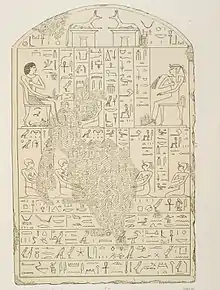Hatshepsut (king's daughter)
Hatshepsut was an ancient Egyptian king's daughter of the 13th Dynasty, around 1750 BC. There are three instances where a person named Hatshepsut is mentioned. It is not known if these are the same or different individuals.

Hatshepsut, daughter of Queen Nofret
She is known from a limestone stela now in the Cairo Egyptian Museum (CG 20394) and found at Abydos,[1][2] where it is stated that she was the daughter of a king's wife Nofret. The name of her royal father is not recorded here. The queen Nofret is not known from other sources.[3] Hatshepsut appears on this stela as wife of the military man Nedjesankh/Iu who had a second wife with the name Nubemwakh. On the stela is also mentioned her daughter, the lady of the houses Nebetiunet.
A 13th–Dynasty scarab
A king's daughter Hatshepsut is also known from a scarab seal. According to Kim Ryholt the scarab can be dated to the time before Sobekhotep III on stylistic grounds.[3]
Hatshepsut, a King's Daughter from the time of Ameny Qemau
In 2017, a 13th Dynasty pyramid at Dahshur was discovered. In the pyramid was found a stone slab with pyramid texts[4] and the name of the king Ameny Qemau. In the same pyramid was found a canopic box naming the king's daughter Hatshepsut,[5] and the fragmented remains of a wooden coffin (later partially reconstructed) carved in a style consistent with a high status female of the Middle Kingdom.[6]
References
- H.O. Lange, H. Schäfer, Grab- und Denksteine des Mittleren Reichs, Theil I: Text zu No. 20001-20399, Berlin, 1902, pp. 393–4
- https://pnm.uni-mainz.de/4/inscription/877
- K.S.B. Ryholt: The Political Situation in Egypt during the Second Intermediate Period, c.1800–1550 BC, Carsten Niebuhr Institute Publications, vol. 20. Copenhagen: Museum Tusculanum Press, 1997, ISBN 8772894210, p. 246
- Ein neues Fragment der Pyramidentexte ist in der Pyramide des Ameny Qemau gefunden (identified by Ivan Bogdanov)
- Owen Jarus: Burial Chamber of Princess Possibly Found in Ancient Egypt Pyramid, in Live Science
- Face of an Egyptian Princess Who Lived 4,000 Years Ago Uncovered